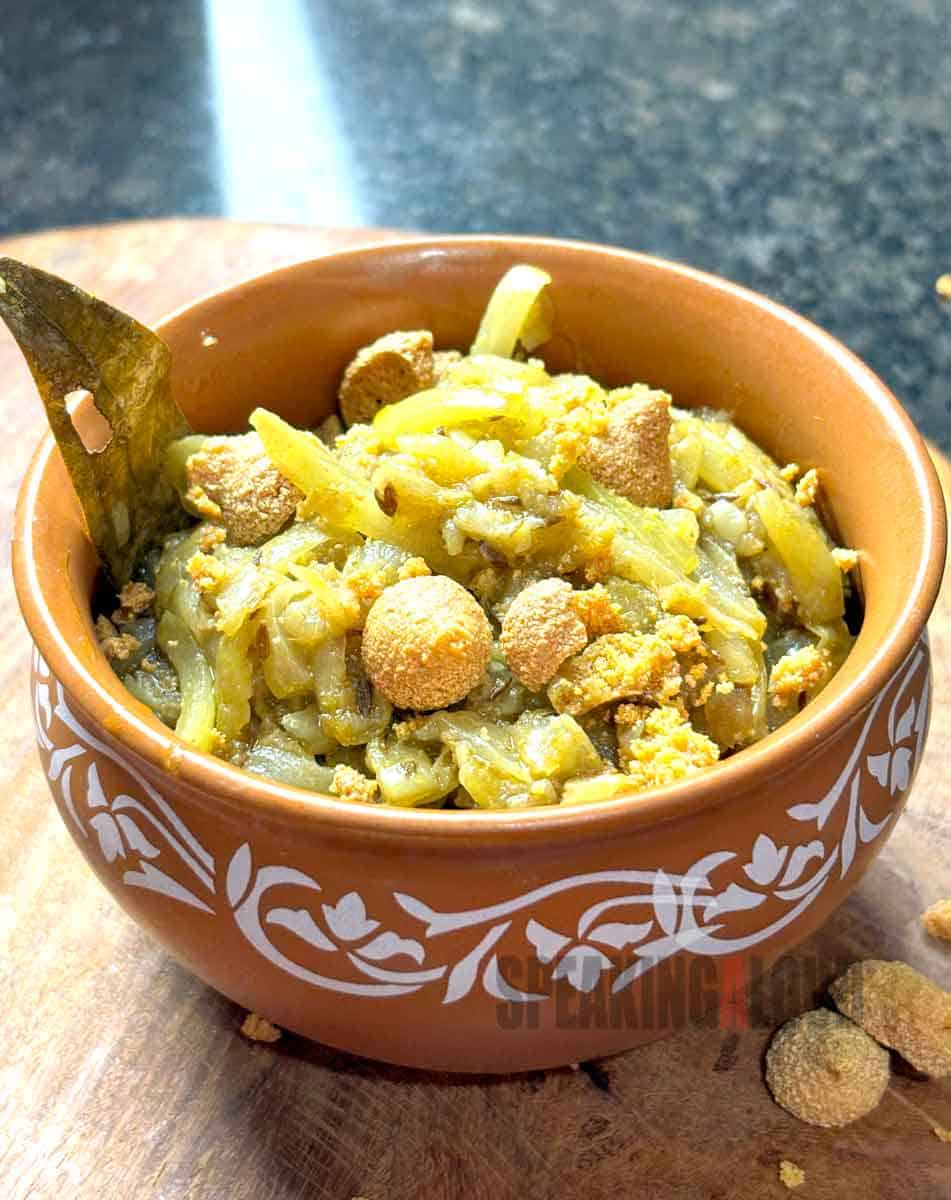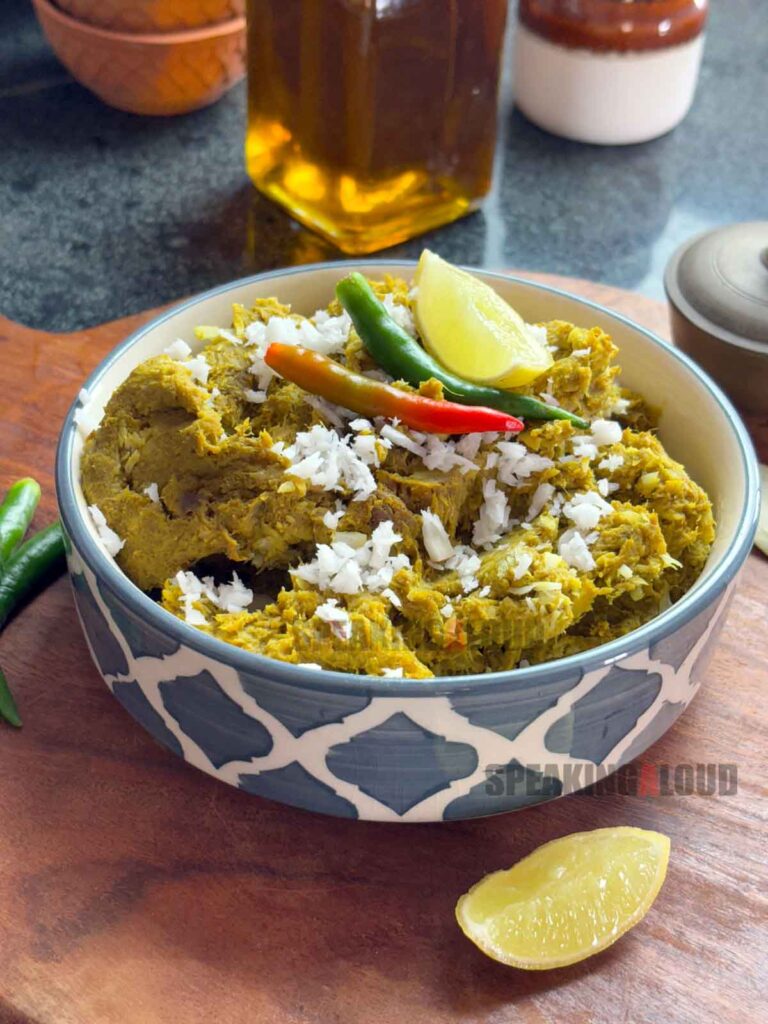This kochu shak ghonto is a traditional Bengali delicacy where the stem of Taro plant is cooked with freshly grated coconut and served with steaming hot rice with fresh green chilies. It has a smooth paste-like texture. It is a niramish ranna recipe or a vegetarian dish with no onion or garlic.
Taro plants are often strewn along Bengal’s large and small water bodies. Owing to their abundance, they have become a staple of everyday Bengali cooking. Numerous recipes use different parts of this plant, such as its roots, stems, and leaves. Although we call this dish ‘kochu shak’, where shak usually means leaves, here we will be cooking with the long brown-colored stems.

How to clean and prep kochu shak er daanta or taro stem
If you are looking for healthier alternatives to other root vegetables, kochu or taro might come out as the front-runner! It is an excellent source of dietary fiber that helps keep your digestive system on track. It is also packed with some of the most essential vitamins. So, if you have been on the fence about including this vegetable in your diet, this is the time to get going. Please keep reading to learn how to peel and cut kochu danta for this ghonto recipe.
- Wash the long stems of kochu danta by rubbing the outer skin under running water to remove any debris or dirt sticking.
- Roughly cut them in foot long pieces. Often green grocers cut the stems into smaller pieces. Even so, the process remains the same, wash them thoroughly to remove any dirt or mud sticking to them.
- Using a knife, peel off the fibrous top skin of the stems by pulling a small piece from the edge. You will see thread-like top skin coming off. Repeat this with all the pieces of the taro stems. While doing this, some of the layers of the stems open up. Peel them as well, and clean them afterward with water if they appear to have dirt on the inside.
- Dice the stem into 6-inch-long pieces and wash them thoroughly once again. Then, let them sit on a sieve to drain excess water.
This way, the kochu danta is ready to be cooked. Cleaning is an important step in preparing these taro stems as these plants often grow in marshy land among the mud. So, it is natural to find mud and debris stuck between the folds of the stems and leaves.
Kochu shak ghonto recipe ingredients
- Kochu Danta ( Taro plant stem ) – I have used 1 large piece of stem weighing just over a kilo.
- Coconut – freshly grated
- Mustard Oil
- Bay leaf or Tej pata
- Coriander powder
- Turmeric powder
- Salt and sugar
- Green chilies
- Tamarind or Lemon juice – an alternate would be vinegar
How to stop kochu shak from causing itchiness?
Taro or kochu shak is a food item that contains calcium oxalate, a chemical compound known to cause itchiness when it comes into contact with the skin. As I begin my prep, my hand immediately starts itching. So, I rub a generous amount of mustard oil on my palm and fingers before I touch the vegetable. If I have kitchen latex gloves available, I wear those.
To make this vegetable safe for consumption, it is necessary to parboil the kochu shak first and drain the water to remove most of the toxins. Subsequently, you can proceed with your recipe and make your kochu shak recipe.
During kochu shak ranna, it is also important to add something acidic that would neutralize any remaining calcium oxalate crystals. Either use a small piece of tamarind or add a splash of lemon juice or vinegar towards the end of cooking. I prefer serving a wedge of lemon with this kochu shak ghonto to eliminate any chances of irritation caused while eating.

Kochu shak danta r ghonto recipe instructions
- You can either boil the kochu danta or taro stems for a couple of minutes, or pressure cook them with a pinch of salt to let them release their water content. You will see that they have turned almost mushy. Sieve them and discard the water.
Make sure to get rid of the water completely as this water pulls out most of the calcium oxalate crystals from the vegetable. - In a large heavy-bottomed pan, heat the mustard oil and drop a couple of bay leaves. Now, add the cooked kochu danta and give everything a very good mix. It would turn mushy and soft.
- Add salt, sugar, a touch of turmeric powder, and coriander powder. Keep mixing everything till it dries up considerably and reduce it to half of its original volume.
- Add the freshly grated coconut and mix it well. As the coconut gets cooked, it releases its oil and adds richness to the dish. You may reserve some for garnish.
- Add green chilies and squeeze a large lemon into the mix before turning the heat off.
- Garnish with some freshly grated coconut before serving.
There are some recipes for kochu shak ghonto with kala chana, and that tastes nice as well. In our family, we like the sweetness and richness of fresh coconut in this kochu shak recipe.
Serving suggestions
Serve this kochu shak r ghonto with some hot rice, along with a wedge of lemon. If possible, then gondhoraj lebu.
More Bengali niramish ranna recipes





Have you tried this recipe? I would love to hear about it. Please leave a comment and star rating if you loved my recipes. It would help this post to reach more readers. Thank you!
Follow me or Subscribe to my Channel

This kochu shak ghonto is a traditional Bengali delicacy where the stem of Taro plant is cooked with freshly grated coconut and served with steaming hot rice with fresh green chilies. It has a smooth paste-like texture. It is a niramish ranna recipe or a vegetarian dish with no onion or garlic.
Course:
Main Course
Cuisine:
Bengali
Diet:
Hindu
Keyword:
Bengali Food, Bengali Vegetarian Recipes, Taro Plant Recipe
Servings: 5 people
:
-
1.5
kilos
Kochu Danta or Taro plant stem
– I have used 1 large piece of stem weighing just over a kilo. -
200
gms
Coconut
– freshly grated -
1
tbsp
Mustard Oil -
2
Bay leaf or Tej pata -
2
tsp
Coriander powder -
½
tsp
Turmeric powder - Salt to Taste
-
½
tsp
Sugar -
2
Green chilies -
Tamarind or Lemon juice
– an alternate would be vinegar
-
You can either boil the kochu danta or taro stems for a couple of minutes, or pressure cook them with a pinch of salt to let them release their water content. You will see that they have turned almost mushy. Sieve them and discard the water.
-
In a large heavy-bottomed pan, heat the mustard oil and drop a couple of bay leaves. Now, add the cooked kochu danta and give everything a very good mix. It would turn mushy and soft.
-
Add salt, sugar, a touch of turmeric powder, and coriander powder. Keep mixing everything till it dries up considerably and reduce it to half of its original volume.
-
Add the freshly grated coconut and mix it well. As the coconut gets cooked, it releases its oil and adds richness to the dish. You may reserve some for garnish.
-
Add green chilies and squeeze a large lemon into the mix before turning the heat off.
-
Garnish with some freshly grated coconut before serving.

